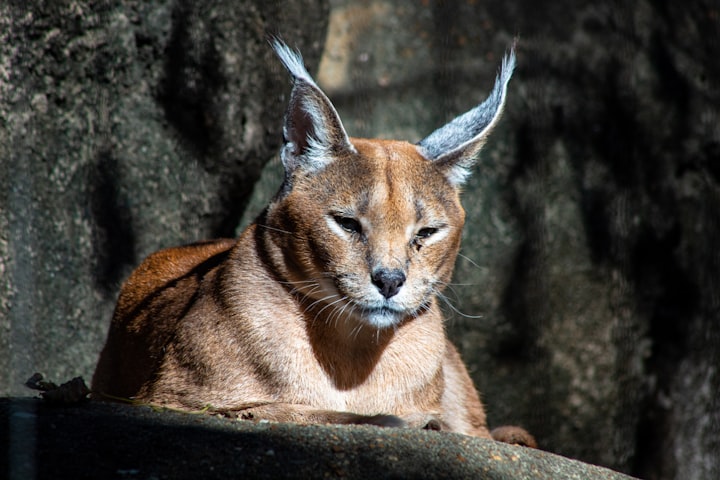
Currently, the Caracal is a highly regarded wild cat worldwide, cherished and kept as pets by many. However, as they are a purebred wild cat originating from Egypt, nurturing them remains a challenge for cat lovers. Explore more about this wild cat species at Sieupet.com!
Formation and Evolution of the Caracal Wild Cat Species
Caracal is known as a revered wild cat species by the Egyptians. This wild cat species is found in the pristine Caracal region of North Africa, often referred to as the desert lynx, and is highly admired by the local people for its elegant and majestic appearance.
According to legend, Caracals were embalmed like humans and underwent burial rites alongside the Pharaohs. The history of this cat species has been propagated over thousands of years through depictions of wild cats carved on the Pyramids.
Furthermore, scientific studies have shown that this species is rare and has existed for over 5 million years, establishing a close relationship with the African Golden Cat - Caracal Aurata, and Serval - Leptailurus Serval.
Due to their habitat distribution primarily in Africa, Southwest Asia, and the Middle East, they are often referred to as the Black-Eared Lynx of Africa, Desert Lynx, Jungle Cat, etc.
Black-eared lynx is often confused with the European Lynx, but Caracal has smooth fur without the black spots of the European lynx.
They also have black markings on their face, running from the forehead to near the mouth, adding to the noble and mythical beauty of the Egyptian wild cat species.
Classification of the Caracal Wild Cat Species
Caracal is discovered with a length ranging mainly from 80cm to 140cm, a height of up to 50cm, and a female weight from 8kg to 12kg, while males are slightly larger, ranging from 12kg to 18kg depending on the individual. Their lifespan can extend up to about 17 years if properly cared for and provided with a suitable environment.
Their habitats include many regions in Africa, preferring the wilderness of nature. Therefore, they are classified and identified in different regions as follows:
- In North Africa, they are called "Caracal Caracal Algeria";
- In East, South, and Central Africa, they are known as "Caracal Caracal Caracal";
- In Israel, Iran, West Asia, Arab, Pakistan, India, Jordan, they are called "Caracal Caracal Schmitzi", and in many other areas, Caracals are known by different names.
Lifestyle of the Caracal Wild Cat Species
These wild cats do not have a herd mentality but instead operate independently like black panthers. They mainly operate at night, and some members will live in pairs. They are quite independent, interacting mainly between mother and offspring or during mating and reproduction.
Despite their magnificent appearance and noble attitude, the character of the black-eared lynx is not much different. They possess the personality of a wealthy entrepreneur, sophisticated, capable of enchanting the hearts of young women in ancient legends. Because of their mysterious and seductive beauty, countless cat lovers have desired to own a wild creature like this cat species.
Natural Environment of the Caracal Wild Cat Species
The lifestyle of this wild cat species is compatible with their behavior. Because they are considered predators in the forest, the best habitat for Caracals is in dense forests, conducive to their hunting instincts.
For those "cat enthusiasts" who want to raise a wild and noble breed like Caracal, they need to pay attention to their living environment. Providing them with a separate and entirely independent space is crucial. Furthermore, since they are a wild cat species with a resolute character and strong fighting ability, interacting with them can be challenging and requires caution as they exhibit their wild instincts.
Mating and Reproduction
Caracals engage in mating activities throughout the year, with each gestation period lasting about 78 to 81 days, giving birth to wild cats from 1 to 6 offspring. Some individuals may hybridize, giving birth to hybrid wild cats, although this is less common.
Newborn Caracals have closed eyes and retractable claws. Although initially gentle like other normal kittens, they grow up to be warriors of the deep forest. After the kittenhood stage, Caracal wild cats open their eyes within 6 to 10 days and are weaned by the mother after 10 weeks of birth. After this stage, they can live independently or continue living with the mother.
Their rapid growth rate corresponds to their daily physical activity. When they reach the "hunting age," they possess strong muscles, agile legs, and sharp vision, preparing for expeditions around the surrounding areas.
Therefore, the "dedicated" ones of the wild cat species should seize this time to capture images of the wild cats. Afterward, it becomes difficult to make them sit still for commemorative photos.
Dietary Regimen
Due to their wild and fierce nature, their diet mainly consists of meat. Some owners feed them raw meat, cleaned to maintain their natural instincts.
Furthermore, the wild environment greatly enhances their hunting abilities, as they mainly prey on small animals and medium-sized birds. Therefore, most of their natural diet consists of raw meat.
However, for families raising Caracals at home, they can supplement their diet with packaged food, similar to other common pet cats. Generally, serving the nutritional needs of this wild cat species is not too difficult.
Moreover, as forest predators, they also target larger prey such as antelopes, deer, etc. Hunting usually takes place at night, where they quickly eliminate their prey by targeting vulnerable areas.
Care for the Caracal Wild Cat Species
If Caracals live in the wild, ecological conservators do not need to provide special care. However, for those planning to raise Caracals as "small members" of their family, there are some factors to consider.
Firstly, there is the issue of poaching, as Caracals are rare, precious, and their bones can be used in traditional medicine, making them targets for poachers of rare forest animals.
Therefore, to self-protect, wild Caracals can be fierce and may attack humans whenever they feel threatened or endangered.
Moreover, in terms of energy consumption, science has proven that Caracals need to supplement their diet with 4% of their body weight to ensure their daily activities. During their growth stage, they may consume more meat than average density. In terms of weather conditions, they usually eat less in hot summers and consume more meat in cold climates.
Finally, using free-range farming methods, prioritizing living on the outskirts of the forest or suburban areas, providing them with enough space for activities and minimizing disturbances to neighboring households.
Price of the Caracal Wild Cat Species
Through understanding the characteristics and personality of Caracal, they truly deserve to be regarded as an elegant and courageous black lynx species. Caracal cats range in price from $1,500 to $20,000, depending on the breeder. However, some rare listings can even reach $30,000. Prices fluctuate due to demand, pedigree, and location. Indeed, this is a high value for wealthy individuals who want to own such a unique wild cat species. However, due to their wild and unpredictable nature, they are not suitable for keeping in urban or residential areas.






Comments
There are no comments for this story
Be the first to respond and start the conversation.